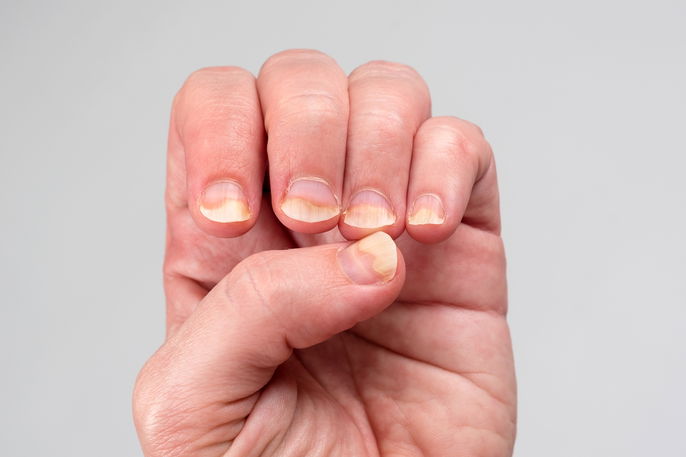Ridges in fingernails are a very common finding, especially in older adults, as they can be caused with normal aging processes. These ridges may also be a sign of other health conditions, however, like anemia, fungal infections, nutritional deficiency and diabetes.
You may notice other changes to fingernails, like thickness changes, shape changes, and color changes. These can occur with other, more systemic symptoms, like headache, fatigue, excessive thirst and pale skin. If you notice these changes and symptoms in addition to fingernail ridges, you should see your doctor for further assessment.
Treatment for ridges depend on the underlying cause. The doctor may recommend dietary changes, antimicrobial ointments, or other specific medications.

What causes ridges in fingernails?
Ridges in the fingernails may occur for the following reasons:
1. Normal aging
It is normal for fingernails to become weaker in general with age. Some people may notice wavy fingernails or visible lines on them. This not a sign of any specific health condition. People with aging fingernails may also experience other signs of aging, like white hair and hormonal changes. É
How to treat: Aging is a natural process and ridges in fingernails may occur in anyone. You can try to mask any ridges by applying clear nail polish and/or filing the nails to improve overall nail appearance.
2. Anemia
Anemia is one of the main causes of fingernail changes. Some people may notice ridges in the fingernails, while others may see more fragile, breaking nails that are opaque in color and lifted in the corners. Anemia is also associated with symptoms like fatigue, pale skin and constant headache. If you suspect you may have anemia, you should see your doctor for assessment.
Read more about the signs and symptoms of anemia.
How to treat: During your assessment, the doctor will identify the underlying cause of anemia. Depending on what triggered it, treatment can consist of dietary changes and increased iron and vitamin B12 intake. More serious cases of anemia may require more targeted interventions, like daily supplement use or a blood transfusion.
3. Fungal infection
A fungal nail infection, also known as onychomycosis, can cause changes to nail shape, thickness and color. Some people may notice ridges in the fingernail, and thicker or harder nails with a yellowish appearance.
How to treat: You are advised to consult a dermatologist, who will identify the type of fungus causing the infection. Once identified, the dermatologist can prescribe specific treatment in the form or oral pills, topical ointments or polish. Treatment is usually prolonged and should be completed as directed by the doctor to prevent further breakouts of fungus.
4. Nutritional deficiency
Some nutritional deficiencies, like vitamin A, vitamin B12 or zinc deficiencies, can lead to fingernail changes, like ridges in the fingernail or rougher fingernails. These conditions can also cause white lines to appear on the outer nail, thicker cuticles and weaker nails in general.
Also recommended: Vitamin B12 Deficiency: Symptoms, Causes & Treatment tuasaude.com/en/vitamin-b12-deficiencyHow to treat: In this case, the deficiency should be diagnosed and dietary habits should be adjusted accordingly. This should improve overall nail appearance as well as your general health status. The doctor may recommend increased consumption of chestnuts, white meats, fish and eggs, which are packed with many vitamins and minerals.
5. Diabetes
In some cases of diabetes, patients may notice increased nail growth and particularly nails with vertical lines that give them a wavy appearance. Other, more common symptoms of diabetes include excessive thirst, weight gain, and increased urination.
How to treat: If you experience any symptoms of diabetes, you should see your family doctor or endocrinologist for diagnosis and treatment. Treatment may involve changes to lifestyle habits, like increased physical activity, as well as diabetes medications to regulate blood sugar levels.






























